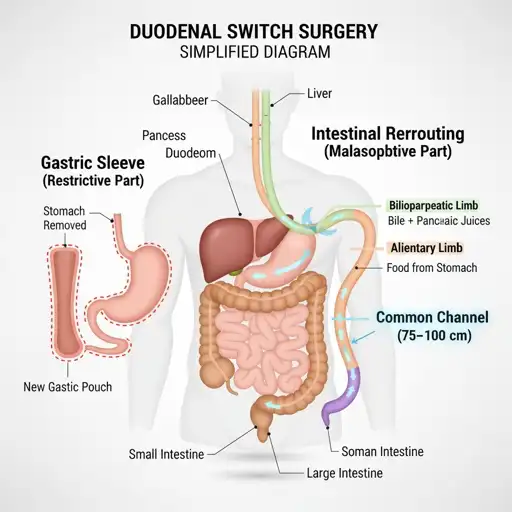
Duodenal Switch Surgery in Mexico
For the Weight You Carry, and the Life You Deserve.
This surgery isn’t just about changing your body — it’s about giving you the freedom to live fully again.
Duodenal Switch (also called BPD-DS: Biliopancreatic Diversion with Duodenal Switch) is one of the most powerful surgical options for severe obesity. It combines a sleeve gastrectomy (making the stomach smaller) with an intestinal bypass to reduce the number of calories and nutrients your body absorbs.
What Is Duodenal Switch (BPD-DS)?
- First, part of your stomach is removed, creating a smaller, tube-shaped stomach (sleeve).
- Next, the small intestine is rearranged so food bypasses a large portion. This causes malabsorption (you absorb fewer calories), helping with weight loss.
- Because of both restriction (smaller stomach) + malabsorption, this surgery typically leads to a faster, greater weight loss than many other options.


Who Is It For?
You might be a good candidate if:
- You have a high BMI (typically over 40, or 35+ with serious health conditions).
- You have not had success with diet, exercise, or less invasive weight loss surgeries.
- You are committed to long-term lifestyle changes: diet, vitamin supplements, regular follow-ups.
- You understand that nutritional care is lifelong: supplements, monitoring, labs.
It’s not for everyone. It’s more complex than sleeve or bypass alone and has higher risk of nutritional deficiencies.
How the Procedure Works
- Pre-op Evaluation — medical history, blood tests, nutritional assessment, plan for supplements.
- Surgery Day — under general anesthesia: sleeve gastrectomy + intestinal rerouting. Surgery usually takes longer than simpler bariatric procedures.
- Hospital Stay & Recovery — usually a few days in hospital, pain management, monitoring.
- Nutrition & Follow-Ups — gradual diet from liquids → soft → regular. Lifelong vitamins, minerals, protein intake are essential. Regular labs to check for deficiencies.
Benefits & Health Improvements
- Major weight loss: often larger and more sustainable than with many other procedures.
- Improvement or resolution of metabolic conditions: type-2 diabetes, high blood pressure, fatty liver, cholesterol.
- Improved quality of life: mobility, sleep, self-confidence.
- Reduction of obesity-related risks: heart disease, joint pain, etc.
Risks, Nutrition & Recovery
- Risks: bleeding, infection, leaks, surgical complications (as with any major surgery).
- Nutritional risks: vitamin A, D, E, K, iron, calcium, protein deficiencies. Must take lifelong supplements.
- Recovery: hospital stay for monitoring, full recovery takes several weeks.
- Lifestyle change: smaller meals, careful food choices, follow medical guidance.
FAQs
- How much weight can I lose & when? Most patients lose a large amount in the first 6-12 months; slower afterward.
- Will I feel weak or tired? Possible if deficiency; protein intake & supplements are very important.
- How long is recovery? Often several weeks for full recovery; hospital stay a few days.
- Is food restriction severe? Yes, especially early; dieticians help you plan safe, balanced meals.
- Will insurance cover this? Usually harder to get insurance coverage; depends on your plan/country.
Our Surgeons

Dr. Jeffry Romero (Left)
- Bariatric Surgeon Certified by the Mexican Council of General Surgery
- With an impeccable track record of +3,000 successful surgeries
Dr. Sergio Verboonen (Right)
- Specialist in General Surgery by the Mexican Council of General Surgery A.C.(9023)
- Mexican Council of Surgery for Obesity and Metabolic Diseases. A.C (COEM1510)
Ready to Get Started?
Our bariatric surgery services offer a path to a healthier, more vibrant you. Whether you’re seeking answers, exploring options, or ready to take the next step, we’re here to guide you. Take the first step towards a transformative change and reach out to us today. Your journey to a happier, healthier life starts here.
